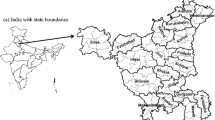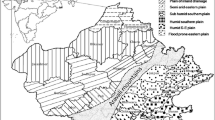Abstract
The Guanzhong Plain, as an important traditional agricultural area, is suffering from high frequency droughts and a trend towards more serious drought. In this paper, eight factors, precipitation, evapotranspiration, surface water availability, depth to groundwater, well yield capacity, slope, potential water storage of soil, and GDP from agriculture, are integrated into an index to represent drought vulnerability based on the overlay and index method. In this approach, according to the internal connections between factors, precipitation and evapotranspiration are integrated into the moisture index, and depth to groundwater and well yield capacity are integrated into groundwater availability. To improve the rationality and accuracy, normalization is employed to assign rating values, and the analytic hierarchy process is introduced into the weighting scheme. Two local drought monitoring datasets endorses the results of the model. The map removal sensitivity analysis indicates the vulnerability index has low sensitivity in removing each layer. The single-parameter sensitivity analysis indicates the major contribution to the vulnerability index is meteorology followed by groundwater availability and surface water availability. The vulnerability map shows the low vulnerability coincides roughly with irrigation districts on the terraces and floodplains. The northwest tableland generally has moderate vulnerability, due largely to inefficient groundwater withdrawal. The high vulnerability is concentrated at the peripheries of the plain, where agriculture is generally rain-fed without irrigation and groundwater support, and land is rugged with high slopes.







Similar content being viewed by others
References
Adger WN (2006) Vulnerability. Glob Environ Chang 16:268–281. doi:10.1016/j.gloenvcha.2006.02.006
Aller L, Bennett T, Lehr JH, Perry RJ, Hackett G (1987) DRASTIC: a standardized system for evaluating groundwater pollution potentials using hydrogeological settings. EPA/600/2–87/035. US Environmental Protection Agency
AMS, American Meteorological Society (2003) Statements of the AMS: Meteorological Drought https://www.ametsoc.org/policy/droughstatementfinal0304.html. Accessed 23 August 2015
Brindha K, Elango L (2015) Cross comparison of five popular groundwater pollution vulnerability index approaches. J Hydrol 524:597–613. doi:10.1016/j.jhydrol.2015.03.003
CMA, China Meteorological Administration (2006) Classification of Meteorological Drought. GB/T 20481–2006, Beijing (in Chinese)
CRED, Centre for Research on the Epidemiology of Disasters (2006) CRED CRUNCH 7: disaster data: a balanced perspective. Brussels
de Carvalho AM, de Carvalho LG, Vianello RL, Sediyama GC, de Oliveira MS, de Sá JA (2013) Geostatistical improvements of evapotranspiration spatial information using satellite land surface and weather stations data. Theor Appl Climatol 113:155–174. doi:10.1007/s00704-012-0772-1
Downing TE, Bakker K (2000) Drought discourse and vulnerability. In: Wilhite DA (ed) Drought: a global assessment, natural hazards and disasters series. Routledge Publishers, U.K.
DROSP, Drought Relief Office of Shaanxi Province, AMCSP, Agricultural Meteorology Center Of Shaanxi Province (1999) Drought Disaster Yearbook of Shaanxi (1949-1995). Xi'an Map Press, Xi'an, China (in Chinese)
ESRI (2016) ArcGIS Desktop Help 10.5. Environmental Systems Research Institute, Redlands, California
Foster T, Brozović N, Butler AP (2015) Analysis of the impacts of well yield and groundwater depth on irrigated agriculture. J Hydrol 523:86–96. doi:10.1016/j.jhydrol.2015.01.032
Freedman D, Pisani R, Purves R (2007) Statistics (fourth edition). W. W. Norton & Company, New York
Gogu RC, Dassargues A (2000) Sensitivity analysis for the EPIK method of vulnerability assessment in a small karstic aquifer, southern Belgium. Hydrogeol J 8(3):337–345. doi:10.1007/s100400050019
Hounsell C (2015) The effect of volcanic ash incorporation, slope and vegetation on soil surface runoff and erodibility characteristics. Dissertation, University of East Anglia
Huan H, Wang JS, Teng YG (2012) Assessment and validation of groundwater vulnerability to nitrate based on a modified DRASTIC model: a case study in Jilin City of Northeast China. Sci Total Environ 440:14–23. doi:10.1016/j.scitotenv.2012.08.037
Jain VK, Pandey RP, Jain MK (2015) Spatio-temporal assessment of vulnerability to drought. Nat Hazards 76:443–469. doi:10.1007/s11069-014-1502-z
Jha MK (2010) Natural and anthropogenic disasters. Springer, Netherlands. doi:10.1007/978-90-481-2498-5
Jia H (2015) Drought early warning system of irrigation district in western Guanzhong plain. Dissertation, Chang’an University (in Chinese)
Kazakis N, Voudouris KS (2015) Groundwater vulnerability and pollution risk assessment of porous aquifers to nitrate: modifying the DRASTIC method using quantitative parameters. J Hydrol 525:13–25. doi:10.1016/j.jhydrol.2015.03.035
Kogan FN (1995) Droughts of the late 1980s in the United States as derived from NOAA polar-orbiting satellite data. Bulletin of the Amrican Meteorological Society 76:655–668. doi:10.1175/1520-0477(1995)076<0655:DOTLIT>2.0.CO;2
Lindoso DP, Rocha JD, Debortoli N, Parente II, Eiró F, Bursztyn M, Rodrigues-Filho S (2014) Integrated assessment of smallholder farming’s vulnerability to drought in the Brazilian semi-arid: a case study in Ceará. Clim Chang 127:93–105. doi:10.1007/s10584-014-1116-1
Lodwick WA, Monson W, Svoboda L (1990) Attribute error and sensitivity analysis of map operations in geographical informations systems: suitability analysis. Int J Geogr Inf Syst 4(4):413–428. doi:10.1080/02693799008941556
Mckee TB, Doesken NJ, Kleist J (1993) The Relationship of Drought Frequency and Duration to Time Scales. In: eighth conference on applied climatology, Anaheim, California
Napolitano P, Fabbri AG (1996) Single-parameter sensitivity analysis for aquifer vulnerability assessment using DRASTIC and SINTACS. HydroGIS 96: Application of Geographic Information Systems in Hydrology and Water Resources Management (Proceedings of the Vienna Conference, April 1996). IAHS Publ. no. 235, pp 559–566
Naumann G, Barbosa P, Garrote L, Iglesias A, Vogt J (2014) Exploring drought vulnerability in Africa: an indicator based analysis to be used in early warning systems. Hydrol Earth Syst Sci 18:1591–1604. doi:10.5194/hess-18-1591-2014
Pacheco FAL, Sanches Fernandes LF (2013) The multivariate statistical structure of DRASTIC model. J Hydrol 476:442–459. doi:10.1016/j.jhydrol.2012.11.020
Pacheco FAL, Pires LMGR, Santos RMB, Sanches Fernandes LF (2015) Factor weighting in DRASTIC modeling. Sci Total Environ 505:474–486. doi:10.1016/j.scitotenv.2014.09.092
Palmer WC (1965) Meteorologic Drought. US Department of Commerce, Weather Bureau, Research Paper No. 45, p. 58.
Palmer WC (1968) Keeping track of crop moisture conditions, nationwide: the new crop moisture index. Weatherwise 21:156–161
Pandey RP, Pandey A, Galkate RV, Byun H, Mal BC (2010) Integrating hydro-meteorological and physiographic factors for assessment of vulnerability to drought. Water Resour Manag 24:4199–4217. doi:10.1007/s11269-010-9653-5
Parry ML, Carter TR, Konijn NT (1988) The impact of climatic variations on agriculture, volume 2: assessment in semi-arid regions. Kluwer Academic Publishers, Dordrecht
Pelling M, Maskrey A, Ruiz P, Hall L (2004) Reducing Disaster Risk: A Chanllenge for Development. Bureau for Crisis Prevention and Recovery, New York
Preziosi E, Del Bon A, Romano E, Petrangeli AB, Casadei S (2013) Vulnerability to drought of a complex water supply system. The upper Tiber Basin case study (Central Italy). Water Resour Manag 27:4655–4678. doi:10.1007/s11269-013-0434-9
Qian H, Li PY, Howard KWF, Yang C, Zhang XD (2012) Assessment of groundwater vulnerability in the Yinchuan plain, Northwest China using OREADIC. Environ Monit Assess 184:3613–3628. doi:10.1007/s10661-011-2211-7
Rahman A (2008) A GIS based DRASTIC model for assessing groundwater vulnerability in shallow aquifer in Aligarh, India. Appl Geogr 28(1):32–53. doi:10.1016/j.apgeog.2007.07.008
Ribeiro L (2000) SI: a new index of aquifer susceptibility to agricultural pollution. ERSHA/CVRM, Instituto Superior Técnico, Lisboa, Portugal
Rosen (1994) A study of the DRASTIC methodology with emphasis on Swedish conditions. Groundwater 32(2):278–285. doi:10.1111/j.1745-6584.1994.tb00642.x
Saaty TL (2004) Decision making — the analytic hierarchy and network processes (AHP/ANP). J Syst Sci Syst Eng 13(1):1–35. doi:10.1007/s11518-006-0151-5
Saaty TL, Shang JS (2011) An innovative orders-of-magnitude approach to AHP-based mutli-criteria decision making: prioritizing divergent intangible humane acts. Eur J Oper Res 214:703–715. doi:10.1016/j.ejor.2011.05.019
Saaty TL, Vargas LG (2012) Models, methods, Concepts & Applications of the analytic hierarchy process, 2nd edn. Springer US, New York
Saha D, Alam F (2014) Groundwater vulnerability assessment using DRASTIC and pesticide DRASTIC models in intense agriculture area of the Gangetic plains, India. Environ Monit Assess 186(12):8741–8763. doi:10.1007/s10661-014-4041-x
Shafer BA, Dezman LE (1982) Development of a surface water supply index (SWSI) to assess the severity of drought conditions in snowpack runoff areas. In: 50th Annual Western Snow Conference, Fort Collins, pp 164–175
Shirazi SM, Imran HM, Akib S (2012) GIS-based DRASTIC method for groundwater vulnerability assessment: a review. J Risk Res 15:991–1011. doi:10.1080/13669877.2012.686053
Simelton E, Fraser EDG, Termansen M, Forster PM, Dougill AJ (2009) Typologies of crop-drought vulnerability: an empirical analysis of the socio-economic factors that influence the sensitivity and resilience to drought of three major food crops in China (1961-2001). Environ Sci Pol 12:438–452. doi:10.1016/j.envsci.2008.11.005
Sun C (2010) A performance evaluation model by integrating fuzzy AHP and fuzzy TOPSIS methods. Expert Syst Appl 37:7745–7754. doi:10.1016/j.eswa.2010.04.066
Şen Z (2015) Practical and applied hydrogeology. Elsevier, Oxford. doi:10.1016/B978-0-12-800075-5.00001-7
Thornthwaite CW (1948) An approach toward a rational classification of climate. Geogr Rev 38:55–94
Tigkas D, Tsakiris G (2015) Early estimation of drought impacts on Rainfed wheat yield in Mediterranean climate. Environ Process 2(1):97–114. doi:10.1007/s40710-014-0052-4
van Duijvenbooden W, van Waegeningh HG (1987) Vulnerability of soil and groundwater to pollutants. In: Vulnerability of soil and groundwater to pollutants: proceedings of the International Conference, Noordwijk aan Zee, The Netherlands
Wang J (2003) Study on water resources rational distributing of Guanzhong irrigation area. Dissertation, Xi'an University of Technology (in Chinese)
Webb RS, Rosenzweig CE (1993) Specifying land surface characteristics in general circulation models: soil profile data set and derived water-holding capacities. Glob Biogeochem Cycles 7:97–108
WFP, Comprehensive Food Security (2009) Comprehensive Food Security & Vulnerability Analysis Guidelines. Rome, Italy
Wilhelmi OV, Wilhite DA (2002) Assessing vulnerability to agricultural drought: a Nebraska case study. Nat Hazards 25:37–58. doi:10.1023/A:1013388814894
Wilhite DA (2009) Drought monitoring as a component of drought preparedness planning. In: Iglesias A, Garrote L, Cancelliere A, Cubillo F, Wilhite DA (eds) Coping with drought risk in agriculture and water supply systems. Springer, Germany
Wilhite DA, Knutson CL (2008) Drought management planning: conditions for success. In: López-Francos A (ed) Drought management: scientific and technological innovations. CIHEAM, Zaragoza, pp 141–148
Woo M (2012) Permafrost hydrology. Springer Berlin Heidelberg, Berlin. doi:10.1007/978-3-642-23462-0_6
Wu J, Sun Z (2016) Evaluation of shallow groundwater contamination and associated human health risk in an alluvial plain impacted by agricultural and industrial activities, mid-West China. Expo Health 8(3):311–329. doi:10.1007/s12403-015-0170-x
Wu H, Chen J, Qian H (2016) A modified DRASTIC model for assessing contamination risk of groundwater in the northern suburb of Yinchuan, China. Environ Earth Sci 75:483. doi:10.1007/s12665-015-5094-z
Xu XH, Lv ZQ, Zhou XY, Jiang N (2016) Drought prediction and sustainable development of the ecological environment. Environ Sci Pollut Res. doi:10.1007/s11356-015-6011-4
Yang X, Lin E, Ma SM, Ju H, Guo LP, Xiong W, Li Y, Xu YL (2007) Adaptation of agriculture to warming in Northeast China. Clim Chang 84:45–58. doi:10.1007/s10584-007-9265-0
Yuan X, Tang B, Wei Y, Liang X, Yu H, Jin J (2015) China’s regional drought risk under climate change: a two-stage process assessment approach. Nat Hazards 76:667–684. doi:10.1007/s11069-014-1514-8
Zehetner F, Miller WP (2006) Erodibility and runoff-infiltration characteristics of volcanic ash soils along an altitudinal climosequence in the Ecuadorian Andes. Catena 65(3):201–213. doi:10.1016/j.catena.2005.10.003
Acknowledgements
The research was supported by the Special Fund for Scientific Research on Public Interest of the Ministry of Water Resources (201301084), the Foundation for the Excellent Doctoral Dissertation of Chang’an University (310829165005, 310829150002). The mean annual precipitation, moisture index, soil texture and GDP from agriculture were obtained from Data Center for Resources and Environmental Sciences, Chinese Academy of Sciences (http://www.resdc.cn). The monthly precipitation used for SPI was obtained from China Meteorological Data Service Center (http://data.cma.cn/en). The ASTER GDEM was obtained from Geospatial Data Cloud (http://www.gscloud.cn/). The authors would like to thank the reviewers for their insightful comments that greatly improved the quality of the paper.
Author information
Authors and Affiliations
Corresponding author
Rights and permissions
About this article
Cite this article
Wu, H., Qian, H., Chen, J. et al. Assessment of Agricultural Drought Vulnerability in the Guanzhong Plain, China. Water Resour Manage 31, 1557–1574 (2017). https://doi.org/10.1007/s11269-017-1594-9
Received:
Accepted:
Published:
Issue Date:
DOI: https://doi.org/10.1007/s11269-017-1594-9




